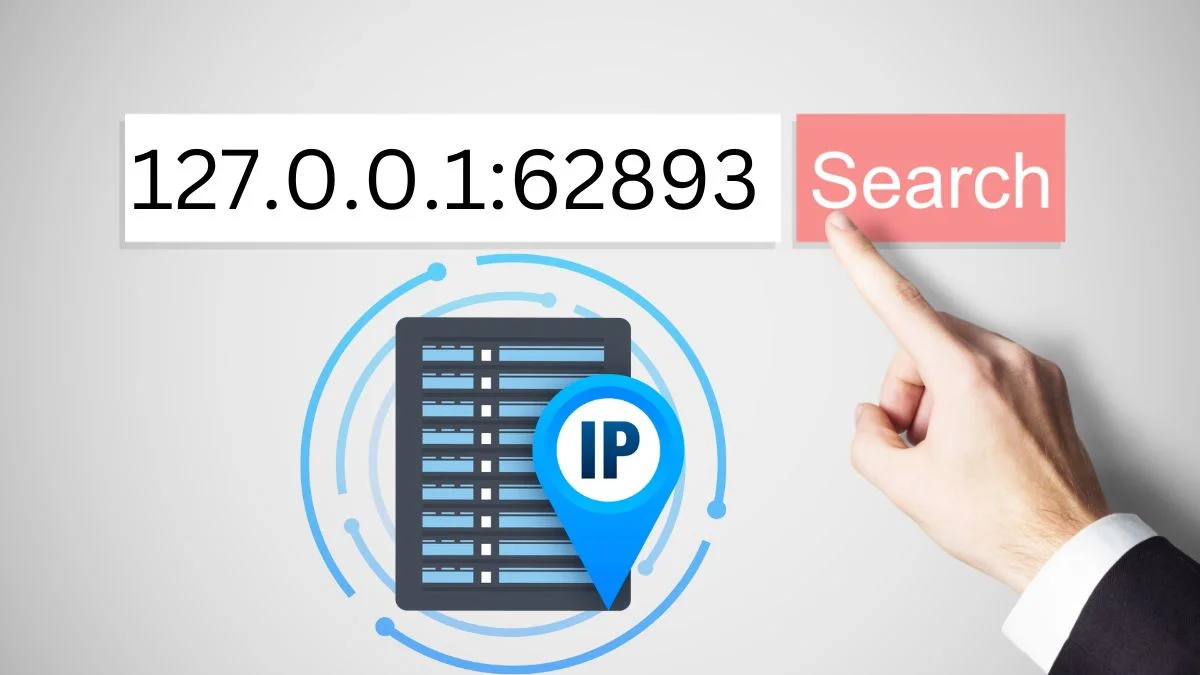127.0.0.1:62893: A Guide To Fix
Ever come across the cryptic sequence 127.0.0.1:62893 while navigating through your computer? It might seem like an enigmatic code from a video game, but there’s a real story behind it, especially if you’re deep into coding.
So, what exactly is 127.0.0.1:62893? Imagine you’re immersed in the development process, and suddenly, you encounter a message: “Disconnected from the target VM, address: 127.0.0.1:62893.” This message is a sign that your computer has lost connection to an essential component.
Don’t worry, though! This article isn’t just about decoding technical jargon. We’ll explain what this sequence signifies, why it appears, and provide solutions for addressing the error it represents. Let’s explore and clarify this digital conundrum together!
What is the Meaning of 127.0.0.1:62893?
Let’s break down this digital puzzle, shall we?

First up is 127.0.0.1, which serves as your computer’s internal communication tool, often referred to as “localhost.” Think of it as a dedicated internal route where messages are sent and received within the system itself. It’s like having a private communication channel within your computer.
Next, we have the number 62893. This is known as a port number, akin to a specific address within a busy network. Port numbers act as entry and exit points for data exchange. While not as widely recognized as ports 80 or 443 (used for web and secure connections, respectively), port 62893 can still play a role in various applications, including Memcached, which is a caching system designed to enhance data retrieval speeds.
In essence, 127.0.0.1:62893 represents your computer saying, “I’m communicating internally, and this is the specific port where I’m handling data.” It’s a small yet significant component in the digital landscape with its own distinct purpose.
Discover Further Insights on IP Addresses
Have you ever wondered how your devices navigate the vast expanse of the internet? That’s where IP addresses come into play. They function as digital coordinates, directing data packets to their correct destinations.
IP addresses come in two main versions: IPv4 and IPv6. IPv4 addresses, like the well-known 127.0.0.1, are the older format. However, they are becoming scarce, much like valuable real estate in a bustling city. This is where IPv6 steps in with its extended address format, providing ample space for more devices to connect to the internet.
When it comes to privacy, think of it like having your own personal space. Devices use private IP addresses, such as 127.0.0.1, for internal communication within a network. When they need to interact with the broader internet, they switch to public IP addresses, allowing them to connect with other devices around the globe.
So, the next time you’re online, whether browsing or streaming, remember that these numerical identifiers are essential for maintaining connections in our digital world.
Explore Deeper into Port Numbers
Imagine your device as a busy apartment building, where different applications reside on various floors. Port numbers are like apartment numbers, guiding data packets to their intended destinations within the building.
Think of it this way: when you change TV channels, each channel directs you to a different show. Similarly, each port number on your device is linked to a specific service or application, ensuring that data packets reach the correct location.
Whether you’re streaming music, sending emails, or having a video call, port numbers work seamlessly behind the scenes to manage data flow efficiently. They function as the unsung heroes of the digital landscape, ensuring everything operates smoothly and accurately.
Practical Applications of Localhost

Ah, localhost – the reliable ally for developers and tech enthusiasts. Let’s explore its key roles:
- Local Development: Imagine you’re a developer working on a groundbreaking project. Before you launch it for the world to see, you need a safe environment to test and refine it. This is where localhost comes in. It provides a secure space for developers to experiment and perfect their work, much like a private workshop where innovations are honed before making their public debut.
- Software Demonstrations: Have you ever wondered how impressive software demonstrations run smoothly without an internet connection? The magic happens thanks to localhost. It acts as a stage where new features and applications can be showcased, all without relying on the often unpredictable nature of online networks. Localhost ensures that software can be presented effectively right from your own device.
So, when you come across localhost, remember – it’s not just a technical term but a crucial component that supports development and showcases software in its finest form.
Tools for Administering Localhost and Ports
When it comes to overseeing and managing localhost and port configurations, several reliable tools can be invaluable:
- Wireshark: Consider Wireshark as your network troubleshooting companion. It’s adept at uncovering network issues and analyzing the traffic within your system. With its robust features, Wireshark provides an in-depth view of your network’s activity, making it easier to diagnose and address connection problems.
- PortQry: If you need to investigate open ports, PortQry is a useful tool. This command-line utility allows you to query and examine open ports efficiently, helping you troubleshoot port-related issues. Think of PortQry as a precision tool for examining port activity, offering a detailed look at what’s happening.
- Nmap: For those interested in network security, Nmap is an essential tool. It excels at scanning networks and identifying open ports, ensuring your network’s integrity and safety. Nmap’s capabilities make it a key player in discovering potential vulnerabilities and safeguarding your digital environment.
Whether you’re diagnosing network issues, investigating port activity, or enhancing security, Wireshark, PortQry, and Nmap are crucial tools that can streamline the management of localhost and port settings. With these tools at your disposal, you’ll have the expertise to handle any network-related challenges.
Benefits of Utilizing 127.0.0.1:62893
The string 127.0.0.1:62893 is far more than just a random assortment of numbers; it’s a valuable asset for developers and network professionals. Here’s why it’s so useful:
- Development and Testing: Imagine you’re deeply engaged in coding a new project. Using 127.0.0.1:62893 allows you to test your applications within a controlled, offline environment. This setup eliminates the need for internet connections and shields your work from external scrutiny. It’s like having a private workspace where you can perfect your code and resolve issues without interruptions.
Don’t Miss Out—Read Now: asciic
- Networking: Curious about how network interactions function? Localhost provides an ideal platform for learning. With 127.0.0.1:62893, you can explore the fundamentals of client-server communication and TCP/IP protocols. It’s akin to having a personal workshop where you can grasp network concepts without complexity.
- Security: Protecting your digital assets is essential, and localhost is a valuable tool in this regard. By monitoring port activity, you can detect potential security threats and unauthorized access attempts. Think of it as having a security system for your network ports, ensuring only legitimate traffic gains entry.
- Debugging: Debugging can be a daunting task, but localhost simplifies the process. By using 127.0.0.1:62893, you can identify and resolve network-related issues more efficiently. It acts as an advanced debugging aid, helping you streamline your applications and improve their performance.
- Isolated Environment: Localhost provides a hassle-free environment for development and testing. With 127.0.0.1:62893, you can create a self-contained space where your applications operate independently. This setup minimizes conflicts and compatibility issues, ensuring a smoother development process.
In summary, 127.0.0.1:62893 is a powerful tool for anyone involved in development or network management. It supports efficient testing, enhances security, simplifies debugging, and ensures a conflict-free environment, all within a secure digital workspace.
Functionality of 127.0.0.1:62893
Let’s unravel the workings of 127.0.0.1:62893:

- Starting the Connection: Picture your device as a vibrant metropolis, where various applications are constantly interacting. When one application wants to communicate with another process, it sends a message.
- Local Destination – 127.0.0.1: Instead of broadcasting this message over the broader internet, it directs it to a local address – 127.0.0.1, commonly known as localhost. This address is like a nearby, reliable neighbor within your own computer, always available to receive and process messages.
- Port Number – 62893: Here’s where things get more precise. Along with the message, the application specifies a port number, 62893, to the operating system. This port number acts as a guide, directing the message to the correct service or application waiting to handle it.
- Real-World Application: For instance, when you’re using a development tool to debug your code, it might use 127.0.0.1:62893 to establish a direct connection with a local server on your machine. This setup ensures that you can troubleshoot and test without external internet interference.
In essence, 127.0.0.1:62893 functions as a direct route for applications to communicate privately and efficiently within your device. It’s akin to having a personal messaging system – streamlined, secure, and confined to your local environment.
Is it Safe to Publicly Expose Port 62893?

Opening port 62893 to the public internet can pose significant risks, and here’s why it’s crucial to be cautious:
- Security Risks: Any service that operates on a port, such as Memcached on port 62893, can have vulnerabilities. If these weaknesses are discovered by malicious actors, they might exploit them to gain unauthorized access to your system, potentially compromising your data and security.
- Risk of Attacks: Imagine your system as a secure fortress, with port 62893 serving as one of its access points. If this port is exposed to the internet, it could attract attackers who might flood your system with excessive traffic or attempt other malicious activities. This could lead to system crashes, data loss, and significant operational disruptions.
- Unauthorized Access: When port 62893 is publicly accessible, anyone with internet access can attempt to connect to your Memcached server. This openness increases the risk of unauthorized access, akin to leaving your home keys in an easily accessible place—convenient but dangerously insecure.
To protect your system, it’s advisable to restrict access to port 62893 so that it is only reachable from within your own network. This precaution helps safeguard against unwanted intrusions and keeps your data secure and under your control.
Addressing Problems with 127.0.0.1:62893
If you’re encountering problems with 127.0.0.1:62893, don’t worry! Here’s a practical guide to help you troubleshoot and resolve the issues:
Determining the Problem

- Confirm Service Operation: Start by ensuring that the service or application you’re trying to reach is active on your device. Whether it’s a local server or a development tool, verify that it’s running correctly.
- Verify Port Configuration: Check that the application is configured to use port 62893. An incorrect port number could be the cause of connectivity issues, so it’s important to double-check the settings.
- Inspect Firewall Rules: Your firewall might be restricting access to port 62893. Access your firewall settings and ensure that traffic to and from this port is allowed, so localhost communications can proceed without obstruction.
Fixing the Problem
- Restart the Service: If your service seems inactive, restart it. This is usually done with a script or a command designed to launch the web server or development tool.
- Change Port Numbers: If port 62893 appears congested or is conflicting with another service, consider using a different port number. Update your application’s configuration to a new port and see if that resolves the issue.
- Adjust Firewall Settings: Ensure that your firewall allows traffic through port 62893. On Windows, you can modify settings through the Control Panel. For Mac or Linux, use Terminal commands to create an exception for this port.
- Review Application Settings: Some applications require specific configurations. Check the application’s documentation to ensure that all settings related to port 62893 are correctly set up.
- Utilize Network Diagnostic Tools: If problems persist, use diagnostic tools like lsof for Unix/Linux or netstat for Windows to identify if port 62893 is being used. If no activity is detected, a deeper investigation into the program’s configuration may be necessary.
These steps will help you troubleshoot and get 127.0.0.1:62893 running smoothly again. Dive into these solutions and get your system back on track!
Correcting the “Disconnected From The Target VM, Address: 127.0.0.1:62893” Error
If you encounter the frustrating “Disconnected From The Target VM, Address: 127.0.0.1:62893” error while using development tools such as VS Code, don’t worry! Here’s a guide to help you resolve this issue:
- Check Service Status: Begin by ensuring that your application or service is active and functioning properly. Sometimes, restarting the service can resolve minor issues and get things running smoothly again.
- Verify Port Settings: Examine the port configuration in your application. Confirm that it aligns with port 62893 as intended. Any discrepancies in the port number can lead to connection errors, so it’s crucial to ensure accuracy.
- Inspect Firewall Rules: Your firewall may be blocking the port necessary for local communication. Review your firewall settings to ensure that port 62893 is not restricted. Allow traffic through this port to facilitate smooth connections.
Is Port 62893 Open to Public Access?

- Denial-of-Service (DoS) Threats: Opening port 62893 to the public increases the risk of DoS attacks. Malicious actors can flood your system with excessive traffic, potentially causing it to crash or become unresponsive. This disruption can significantly impact your system’s operations.
- Unauthorized Access: Publicly accessible port 62893 allows anyone on the internet to attempt a connection to your Memcached server. This exposure can lead to unauthorized access attempts, potentially compromising sensitive data or exploiting system vulnerabilities.
- Security Weaknesses: If there are existing security flaws in the Memcached service on port 62893, they can be targeted by attackers. This could result in unauthorized access, data breaches, or other harmful actions that compromise your system’s security and integrity.
To protect your system, it is advisable to limit access to port 62893 to trusted users and systems within your network. This precaution helps maintain security and safeguard your system from potential threats.
Securing Port 62893
- Network Segmentation: Implement network segmentation to limit access to port 62893. By dividing your network into distinct segments, you can control which devices or users are permitted to connect to the port, reducing the exposure to potential attacks.
- Access Control Lists (ACLs): Use access control lists to regulate access to port 62893 based on criteria like IP addresses, protocols, or specific times. ACLs help ensure that only authorized entities can connect to the port, enhancing overall security.
- Encryption: Enable encryption technologies such as SSL/TLS for data transmitted over port 62893. This encryption safeguards sensitive information from being intercepted or accessed by unauthorized individuals.
- Regular Updates and Patches: Keep the Memcached service associated with port 62893 updated with the latest security patches and software updates. Regular maintenance helps address known vulnerabilities and reduces the risk of exploitation.
- Monitoring and Logging: Set up robust monitoring and logging systems to track activity on port 62893. By analyzing logs and monitoring for unusual access attempts, you can swiftly detect and respond to potential security incidents, ensuring timely intervention.
FAQs
1. What is port 62893, and why is it important? Port 62893 is commonly associated with specific services like Memcached in local development environments. It plays a crucial role in managing how data is transmitted and received through a network. Properly securing it is essential to prevent unauthorized access and maintain network integrity.
2. What risks are involved with exposing port 62893 to the public? Exposing port 62893 to the public can lead to various security risks, including denial-of-service (DoS) attacks, unauthorized access, and exploitation of vulnerabilities. These risks can compromise system performance and data security.
3. How can I secure port 62893? To secure port 62893, you can implement network segmentation, use access control lists (ACLs), enable encryption protocols, regularly update and patch the associated services, and set up monitoring and logging systems to detect and respond to potential threats.
4. What steps should I take if I encounter issues with port 62893? If you face issues with port 62893, ensure that the related service is running, verify the port configuration, and check your firewall settings. You might also consider restarting the service or changing the port number to resolve conflicts.
5. Why is it not recommended to leave port 62893 open to the internet? Leaving port 62893 open to the internet can expose your system to potential attacks and unauthorized access. This can lead to data breaches, system disruptions, and other security vulnerabilities. It’s best to restrict access to trusted users or within a secure network environment.
Conclusion
Securing port 62893 is crucial for maintaining a robust and secure network environment. By understanding the risks associated with exposing this port and implementing best practices such as network segmentation, access control, encryption, and regular updates, you can significantly enhance the protection of your system. Addressing any issues promptly and ensuring that only authorized users have access will help safeguard against potential threats and ensure the integrity of your network and data.
Stay updated and alerted by staying connected! Uswiremagazine
